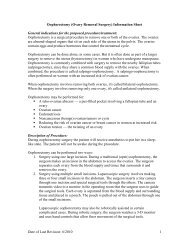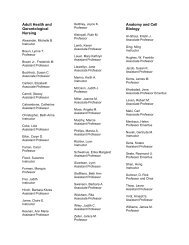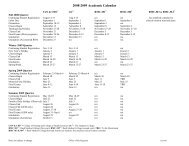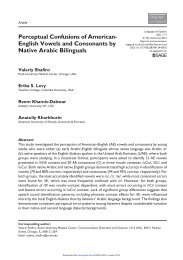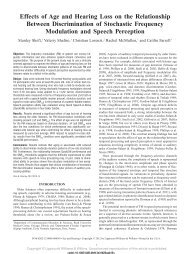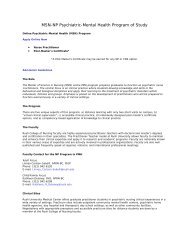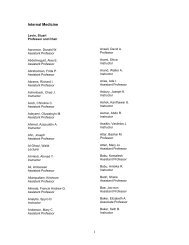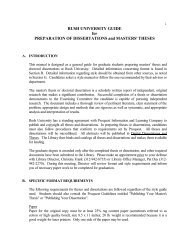Perceptual confusions of American English vowels ... - Rush University
Perceptual confusions of American English vowels ... - Rush University
Perceptual confusions of American English vowels ... - Rush University
Create successful ePaper yourself
Turn your PDF publications into a flip-book with our unique Google optimized e-Paper software.
6pSWa28. Word-level rhythm in non-native <strong>English</strong>. Rachel E. Baker<br />
Dept. <strong>of</strong> Linguist., Northwestern Univ., 2016 Sheridan Rd., Evanston, IL<br />
60208-4090, r-baker2@northwestern.edu, Laurent Bonnasse-Gahot Ecole<br />
des Hautes Etudes en Sci. Sociales, Paris 75006, France, Kristin J. Van<br />
Engen, Melissa Baese-Berk, and Midam Kim Dept. <strong>of</strong> Linguist., Northwestern<br />
Univ., Evanston, IL 60208-4090<br />
Motivated by traditional rhythm class typologies, studies <strong>of</strong> languagelearners’<br />
rhythm typically focus on the syllable or segment level. Studying<br />
word-level rhythm lets us explore the effects <strong>of</strong> lexical features e.g., part <strong>of</strong><br />
speech, predictability on word durations in non-native speech. This study<br />
examined whether native and non-native <strong>English</strong> can be distinguished by<br />
variation in the realization <strong>of</strong> <strong>English</strong> lexical features, and whether nonnative-like<br />
word-level rhythm leads to a stronger foreign accent. Word durations<br />
were measured in <strong>English</strong> paragraphs read by 12 native <strong>American</strong><br />
<strong>English</strong> AE, 20 native Korean, and 20 native Chinese speakers. AE listeners<br />
rated the “accentedness” <strong>of</strong> these speakers. AE speakers showed greater<br />
within-speaker word duration variance than non-natives, and non-native<br />
speakers with greater variance received more native-like accent ratings. Increased<br />
AE variance had two causes. AE speakers had shorter relative durations<br />
for function words than non-natives. AE speakers also showed<br />
greater variance in their content word durations than non-natives, perhaps<br />
due to differences between words with and without pitch accents. However,<br />
both AE and non-native speakers produced shorter second mentions <strong>of</strong><br />
words than first mentions, showing sensitivity to lexical predictability. Overall,<br />
these findings implicate word-level rhythm as an important and complex<br />
feature <strong>of</strong> foreign-accented <strong>English</strong>.<br />
6pSWa29. <strong>English</strong> vowel contrast perception on monolingual and<br />
bilingual 4- to 7-year olds: Behavioral and neurophysiological evidence.<br />
Yan Yu, Nancy Vidal, Hia Datta, Jennifer Gerometta, and Valerie Shafer<br />
Speech-Lang.-Hearing Sci., the Graduate Ctr., City Univ. <strong>of</strong> New York,<br />
New York, NY 10016<br />
The role <strong>of</strong> simultaneous bilingual language exposure on speech perception<br />
development has been far from definitive. Behavioral literature has been<br />
controversial in terms <strong>of</strong> whether bilingual children keep pace with their<br />
monolingual peers Burns et al. 2007; Sundara et al. 2006. The purpose<br />
<strong>of</strong> the current study is to: 1 investigate whether bilingual exposure to<br />
Spanish and <strong>English</strong> affects processing <strong>of</strong> speech stimuli that are phonemic<br />
only in <strong>English</strong> in children from 4–7 years <strong>of</strong> age; 2 whether the eventrelated<br />
potential ERP measures correlate with the behavioral measure<br />
e.g., phoneme identification. Phonetically similar vowel contrasts I versus<br />
E were presented in an oddball paradigm while ERPs were collected from<br />
65 scalp sites. Vowel discrimination and vowel identification were carried<br />
out using I-E vowel continuum. Preliminary analyses suggest that there is no<br />
difference in how monolingual and bilingual children behaviorally identify<br />
this vowel contrast. In terms <strong>of</strong> the ERP responses, children in both groups<br />
showed vowel discrimination as indexed by the presence <strong>of</strong> mismatch responses<br />
MMRs. Younger children tended to still have a positive MMR that<br />
preceded the adult-like negative MMR. Individual patterns <strong>of</strong> response will<br />
be discussed in relation to amount <strong>of</strong> <strong>English</strong> versus Spanish exposure.<br />
6pSWa30. Using voice quality to learn non-native tonal categories.<br />
Kristine M. Yu Dept. <strong>of</strong> Linguist., Univ. <strong>of</strong> California, Los Angeles, 3125<br />
Campbell Hall, Los Angeles, CA 90095, krisyu@humnet.ucla.edu<br />
An artificial language learning experiment will be used to study if voice<br />
quality can be used to learn tonal systems. Cross-linguistically, tone, and<br />
voice quality can co-vary in different ways. For instance, Mazatec Jalapa de<br />
Diaz, has three phonation types modal, breathy, creaky fully crossed with<br />
three level tone levels Ladefoged et al. 1988, while Mandarin has creaky<br />
phonation in Tone 3 and Tone 4, which are also distinguished from one another<br />
and Tone 1 and 2 by f0 contour Davison 1991; Belotel-Grenié and<br />
Grenié 2004. The goal <strong>of</strong> the study is to investigate if <strong>English</strong> listeners<br />
unfamiliar with tone languages can use phonation-type contrasts to learn<br />
tonal contrasts in artificial tone languages differing in how tone and voice<br />
quality co-vary. There will be a comparison <strong>of</strong> how learners generalize from<br />
training to novel stimuli for artificial languages where voice quality and tone<br />
contrasts are correlated and uncorrelated cues.<br />
6pSWa31. Intelligibility <strong>of</strong> Spanish-accented <strong>English</strong> words in noise.<br />
Jonathan Dalby Dept. <strong>of</strong> Audiol. and Speech Sci., Indiana Univ.-Purdue<br />
Univ., Fort Wayne, 2101 E. Coliseum, Ft. Wayne, IN 46805,<br />
dalbyj@ipfw.edu and Catherine L. Rogers Univ. <strong>of</strong> South Florida, Tampa,<br />
FL 33620<br />
The intelligibility <strong>of</strong> Mandarin-accented <strong>English</strong> sentences, even those<br />
spoken by highly pr<strong>of</strong>icient non-native speakers, is degraded more than is<br />
native speech when presented to native listeners in noise Rogers et al.<br />
2004. Comprehension <strong>of</strong> accented speech may require more processing<br />
time than native speech even when presented in quiet Munro and Derwing<br />
1995. These effects are similar to effects found by Pisoni and his colleagues<br />
for synthetic, as compared to natural speech Winters and Pisoni<br />
2003 and together suggest that the ability <strong>of</strong> native listeners to adapt relatively<br />
quickly and effectively to accented speech Bradlow and Bent 2008;<br />
Clark and Garrett 2004 may come at the expense <strong>of</strong> increased cognitive<br />
effort. The present study examines the effects <strong>of</strong> noise on the intelligibility<br />
<strong>of</strong> Mandarin-accented isolated words from speakers representing a wide<br />
range <strong>of</strong> oral <strong>English</strong> pr<strong>of</strong>iciency based on connected-speech measures. A<br />
subset <strong>of</strong> these words, those with the highest open-set identification scores<br />
as rated by a jury <strong>of</strong> 10 native listeners, will be presented for identification<br />
to a second jury at four signal-to-noise ratios: quiet, 10, 0, and 5 dB.<br />
Results are compared to those found for connected speech from the same<br />
group <strong>of</strong> talkers. Work supported by NIH-NIDCD.<br />
6pSWa32. Infant dialect discrimination. Jennifer Phan and Derek M.<br />
Houston Dept. <strong>of</strong> Otolaryngol., Indiana Univ. School <strong>of</strong> Medicine, 699<br />
West Dr., Indianapolis, IN 46202, jphan@iupui.edu<br />
To understand speech, infants must differentiate between phonetic<br />
changes that are linguistically contrastive and those that are not. Research<br />
has shown that infants are very sensitive to fine-grained differences in<br />
speech sounds that differentiate words in their own or another language.<br />
However, little is known about infants’ ability to discriminate phonetic differences<br />
associated with different dialects <strong>of</strong> their native language. Using a<br />
visual habituation procedure, 7-, 11-, 18-, 24-, and 30-month olds were<br />
tested on their ability to discriminate two linguistically equivalent variants<br />
<strong>of</strong> the diphthong /aI/—one produced in their native dialect North Midland<br />
<strong>American</strong> <strong>English</strong> versus one produced in a non-native dialect Southern<br />
<strong>American</strong> <strong>English</strong>. Seven-month olds discriminated the variants but 11-<br />
month olds did not. Infants from 18–30 months <strong>of</strong> age did not demonstrate<br />
statistically significant discrimination, but they did show a trend toward discrimination<br />
with increasing age. The findings suggest that dialect discrimination<br />
follows a U-shaped course <strong>of</strong> development. Because 11-month olds<br />
demonstrated the poorest dialect discrimination performance, we are currently<br />
assessing their ability to discriminate linguistically different speech<br />
sounds varying in degree <strong>of</strong> acoustic similarity. Preliminary findings suggest<br />
that both language experience and acoustic differences may influence infants’<br />
discrimination <strong>of</strong> phonetic contrasts in the native language. Work<br />
supported by NIH-NIDCD Grant R01DC006235, an IUPUI Educational<br />
Enhancement Grant, and grants from the IUPUI UROP and SROP<br />
Programs.<br />
6pSWa33. Perception <strong>of</strong> second-language (L2) production by<br />
first-language (L1) speakers <strong>of</strong> different dialectal backgrounds: The case<br />
<strong>of</strong> Japanese-speaking learners’ /u/ perceived by French and Quebec<br />
native speakers. Marie-Claude Tremblay Dept. <strong>of</strong> Linguist., Univ. <strong>of</strong> Ottawa,<br />
70 Laurier Ave. E., Ottawa, ON Canada, K1N 6N5,<br />
mtrem075@uottawa.ca and Takeki Kamiyama CNRS/Sorbonne Nouvelle,<br />
75005 Paris, France<br />
The high back rounded /u/ <strong>of</strong> Parisian French PF is characterized by a<br />
concentration <strong>of</strong> energy in the low frequency zone 1000 Hz duetothe<br />
grouping <strong>of</strong> the first two formants, while Quebec French QF has a “lax”<br />
variant U in closed syllables as in “soupe”, with its F2 amounting to<br />
1000–1100 Hz P. Martin, “Le système vocalique du français du Québec. De<br />
l’acoustique à la phonologie.” La linguistique, 382, 71–88 2002.<br />
Japanese-speaking learners <strong>of</strong> French JSL tend to produce French /u/ with<br />
high F2 as in Japanese /u/, which in turn tends to be perceived by PF lis-<br />
2776 J. Acoust. Soc. Am., Vol. 125, No. 4, Pt. 2, April 2009 157th Meeting: Acoustical Society <strong>of</strong> America 2776



